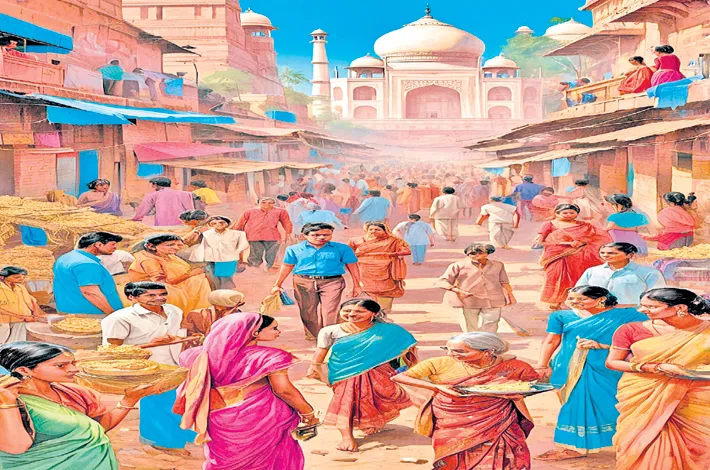The Art of Survival in Middle-Class Lives in India
15-05-2025 12:00:00 AM

Education, a cornerstone of middle-class aspiration, is another financial tightrope. Parents invest heavily in their children’s schooling, often prioritizing private institutions over government ones for perceived quality. Coaching classes for competitive exams like JEE, NEET, or UPSC are a cultural norm, with families spending thousands of rupees monthly to secure a brighter future for their children
In India, the middle class is a vibrant, dynamic segment of society, often described as the backbone of the nation’s economy and culture. Numbering around 400 million people (as per recent estimates), this group is neither affluent nor destitute, navigating a delicate balance between aspiration and constraint. The art of survival for India’s middle class is a masterclass in resilience, resourcefulness, and adaptability, shaped by economic pressures, cultural expectations, and a rapidly evolving socio-economic landscape.
The Middle-Class Identity
The Indian middle class is diverse, encompassing urban professionals, small business owners, government employees, and skilled workers in tier-2 and tier-3 cities. Their income levels vary widely, typically ranging from ₹5 lakh to ₹20 lakh per annum, but what unites them is a shared ethos: a drive for upward mobility, education, and stability. Unlike the elite, who have wealth to cushion uncertainties, or the poor, who rely on survival instincts honed by necessity, the middle class operates in a precarious middle ground. They are dreamers with one foot in ambition and the other in pragmatism, juggling societal expectations with limited resources.
Economic Pressures and Financial Juggling
For the Indian middle class, financial survival is an intricate dance. Rising costs of living, especially in urban centers like Mumbai, Delhi, and Bengaluru, strain household budgets. Housing, often the largest expense, is a significant burden. Many middle-class families live in modest 1 or 2 BHK apartments, with skyrocketing real estate prices making homeownership a distant dream for some. Rent and EMIs consume a substantial portion of income, leaving little for discretionary spending.
Education, a cornerstone of middle-class aspiration, is another financial tightrope. Parents invest heavily in their children’s schooling, often prioritizing private institutions over government ones for perceived quality. Coaching classes for competitive exams like JEE, NEET, or UPSC are a cultural norm, with families spending thousands of rupees monthly to secure a brighter future for their children. Healthcare costs further exacerbate financial stress, as private hospitals are often preferred due to inefficiencies in public healthcare. A single medical emergency can wipe out years of savings, pushing families to rely on loans or insurance, if they have it.
The art of survival here lies in meticulous budgeting and prioritization. Middle-class households are adept at stretching every rupee, whether through bulk-buying groceries, negotiating with vendors, or opting for second-hand goods. Many supplement their income through side hustles—freelancing, tutoring, or small entrepreneurial ventures like selling homemade snacks or crafts. The gig economy, facilitated by platforms like UrbanClap or Swiggy Instamart, has provided new avenues for earning, though often at the cost of work-life balance.
Cultural Expectations and Social Navigation
Beyond economics, the middle class in India grapples with intense social and cultural pressures. The family unit is central, and obligations to parents, siblings, and extended relatives often take precedence over personal desires. Arranged marriages, though less rigid than in the past, remain common, with families spending significant sums on weddings to uphold social status. The pressure to “keep up appearances” is palpable—whether it’s buying a car to match neighbors or hosting lavish festivals like Diwali.
The middle class also faces the paradox of modernity versus tradition. While urban families embrace globalized lifestyles—think Netflix subscriptions and international vacations—they are equally rooted in cultural norms, such as caring for aging parents or celebrating religious festivals with fervor. Women, in particular, bear the brunt of this duality, balancing careers with household responsibilities. The art of survival here involves negotiation: knowing when to push against societal norms and when to conform to maintain harmony.
Education and Aspiration as Survival Tools
Education is the middle class’s greatest weapon in their survival arsenal. It’s seen as the ticket to a better life, a way to break free from financial insecurity. Parents sacrifice luxuries to afford quality schooling, and students face immense pressure to excel in board exams and secure spots in prestigious institutions. The IITs, IIMs, and government jobs remain the holy grail, symbolizing stability and prestige. Yet, the competition is fierce—only 1% of JEE aspirants secure seats in top-tier IITs, and UPSC success rates are even lower.
This relentless pursuit of education shapes the middle-class psyche. Failure is not an option, and the fear of slipping back into poverty looms large. The art of survival here is mental fortitude—students and parents alike cultivate resilience to withstand setbacks, from exam failures to job rejections. Community support, such as study groups or family encouragement, plays a crucial role in keeping aspirations alive.
Adapting to a Changing India
India’s middle class is not static; it evolves with the nation’s economic and technological shifts. The rise of digitalization has been a game-changer. Online banking, UPI payments, and e-commerce platforms like Amazon and Flipkart have made life more convenient, allowing families to compare prices and save money. However, digital literacy varies, and older generations sometimes struggle to keep up, relying on younger family members for tech-related tasks.
The gig economy and startup culture have also reshaped middle-class survival strategies. Young professionals are increasingly opting for entrepreneurial ventures or freelance work over traditional 9-to-5 jobs, driven by the promise of flexibility and higher earnings. Yet, this comes with risks—unstable incomes and lack of job security. The middle class adapts by diversifying income streams and embracing lifelong learning to stay relevant in a competitive job market.
The Emotional Core of Survival
At its heart, the art of survival for India’s middle class is emotional as much as it is practical. Optimism and hope fuel their daily grind. Festivals, family gatherings, and small milestones—like a child’s graduation or a new home—provide moments of joy amidst the struggle. Community networks, whether neighbors, colleagues, or religious groups, offer a safety net, reinforcing the idea that no one survives alone.
The middle class also finds solace in small indulgences: a weekend movie, a family outing to a local eatery, or a new gadget bought after months of saving. These moments of joy are carefully curated, a reminder that survival is not just about enduring but also about living.
Conclusion
The art of survival in India’s middle class is a testament to human ingenuity. It’s about balancing dreams with reality, navigating economic constraints with cultural pride, and finding joy in the mundane. This segment of society embodies resilience, not through grand gestures but through everyday acts of perseverance—whether it’s a mother skipping a meal to pay for her child’s tuition or a father working overtime to fund a family wedding. In a country of contrasts, the middle class thrives by embracing adaptability, community, and an unyielding belief in a better tomorrow. Their story is not just one of survival but of triumph, painting a vivid picture of what it means to live, love, and aspire in modern India.








